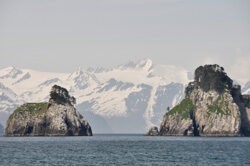
The Tlingit and Haida tribes of the area, as well as the steamships of the gold rush era, used this passageway frequently. In the present day, it serves as a vital passageway for cruise ships and ferries on the Alaska Marine Highway. The area south of Glacier Bay is home to the Alexander Archipelago, which is made up of thousands of islands of varying sizes. The Inside Passage, a section of the coast further inland, is protected from rough seas by the islands in this chain.
Navigating Southeast Alaska is challenging due to the area’s steep, rocky terrain and numerous islands and fjords. The two northmost towns in the area are Haines and Skagway, which have access to the Alaska Highway. In general, only boats and planes can get you from one island to another or from one city to another.
Over the past ten thousand years, Southeast Alaska has been home to maritime people. They have ties to the earliest settlements of the Northwest Coast Tribes. The Alaska Native people keep up their “connection with nature” by maintaining their own cultural practices. There is a wealth of oral history that has been passed down through the generations, telling of a continuous presence on the continent since “time immemorial.”